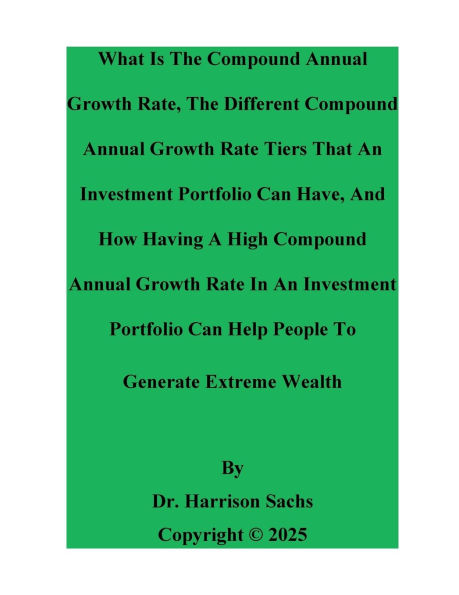Home
What Is The Compound Annual Growth Rate And Different CAGR Tiers That An Investment Portfolio Can Have



What Is The Compound Annual Growth Rate And Different CAGR Tiers That An Investment Portfolio Can Have in Bloomington, MN
Current price: $21.99
Loading Inventory...
Size: Paperback
This essay sheds light on what is the compound annual growth rate, demystifies the different compound annual growth rate tiers that an investment portfolio can have, and expounds upon how having a high compound annual growth rate in an investment portfolio can help people to generate extreme wealth. Succinctly stated, the compound annual growth rate is deemed to be "the mean annual growth rate of an investment over a period longer than one year". In other words, the compound annual growth rate is able to demystify "a smoothed rate of return" that reflects the rate of return that "an investment yields on an annually compounded basis". The compound annual growth rate is in the form of a pro forma number. The compound annual growth rate formula has tremendous utility. The compound annual growth rate formula can be leveraged by investors to discover the earnings growth rate of companies "on an annually compounded basis". Discovering the earnings growth rate of companies "on an annually compounded basis" can allow investors to ascertain how disparate companies "earnings perform over time on an annually compounded basis". By ascertaining how different companies "earnings perform over time on an annually compounded basis", investors are at a higher probability to implement informed investment decisions. The compound annual growth rate formula lacks the innate limitations of the arithmetic average return. The arithmetic average return does not take into account the compounding effect of an investment. The arithmetic average return also does not factor in the reinvestment of dividends in an investment. The reinvestment of dividends in an investment can affect the return on an investment over time. As a corollary of the arithmetic average return not taking into account the compounding effect of an investment, "it can overstate the actual average return" of an investment. The arithmetic average return is also less accurate than the geometric mean for ascertaining the average return of an investment over ample annual consecutive periods of time. The geometric mean can be leveraged by investors to ascertain the average return of an investment over ample annual consecutive periods of time. The compound annual growth rate formula can be leveraged by investors to discover "the mean annual growth rate of an equity on an annually compounded basis". Investors become all the more enticed to purchase equities from companies in contexts in which they are able to maintain a steep net earnings growth rate for a myriad of consecutive years. The compound annual growth rate formula can also be leveraged by investors to discover "the mean annual growth rate of" disparate types of investments "on an annually compounded basis". The utility of the compound annual growth rate formula extends beyond the ambit of the compound annual growth rate formula being leveraged by investors to discover "the mean annual growth rate of" a stock "on an annually compounded basis". The compound annual growth rate formula can also be leveraged by investors to discover "the mean annual growth rate of an" index mutual fund "on an annually compounded basis", discover "the mean annual growth rate of an" actively managed mutual fund "on an annually compounded basis", discover "the mean annual growth rate of an" index exchange-traded fund "on an annually compounded basis", discover "the mean annual growth rate of an" actively managed exchange-traded fund "on an annually compounded basis", and discover "the mean annual growth rate of" a corporate bond "on an annually compounded basis". Investors become all the more enticed to purchase investment securities from companies in contexts in which the companies are able to maintain a steep compound annual growth rate for an exorbitant amount of consecutive years. Even though the compound annual growth rate formula can be leveraged by investors to discover "the mean annual growth rate of" disparate types of investments "on an annually compounded basis", it is nonetheless unable to demystify all the characteristics of an investment security. The compound annual growth rate formula is unable be leveraged by investors to elicit the investment risks of disparate types of investments. Furthermore, the compound annual growth rate formula is also unable be leveraged by investors to elicit the volatility risks of disparate types of investments. Even though the compound annual growth rate is in the form of a pro forma number, it is nonetheless limited in scope since it does not demystify the totality of characteristics of an investment security. There are a bevy of different compound annual growth rate tiers that an investment portfolio can have. Some of the different compound annual growth rate tiers that an investment portfolio can have encompass a very high compound annual growth rate tier, a high compound annual growth rate tier, a medium compound annual growth rate tier, and a low compound annual growth rate tier.

















